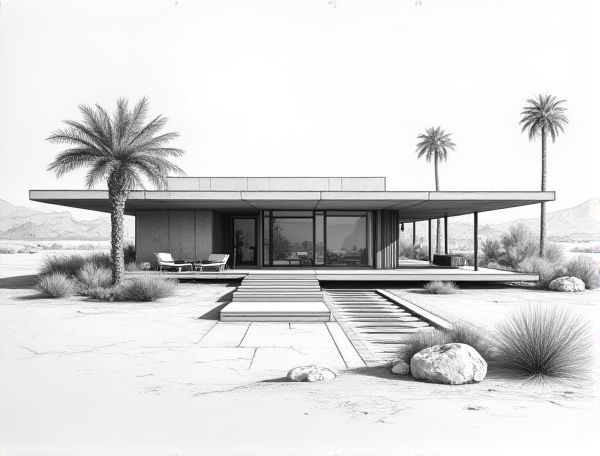
Photo illustration: Desert modernism home design with thermal mass cooling
Desert modernism home design utilizes thermal mass cooling techniques to naturally regulate indoor temperatures by absorbing heat during the day and releasing it at night, enhancing energy efficiency and comfort in arid climates. Explore the article to discover how you can integrate these sustainable design principles into your dream home.
Introduction to Desert Modernism Home Design
Desert Modernism home design merges sleek, minimalist architecture with natural desert landscapes, emphasizing clean lines, open spaces, and sustainable materials. Your living space harmonizes with the arid environment through large glass walls, flat roofs, and desert-adapted vegetation, promoting indoor-outdoor living. This design style prioritizes energy efficiency and integrates local stone, wood, and concrete to create a timeless, eco-friendly desert retreat.
Principles of Thermal Mass Cooling
Thermal mass cooling in home designing relies on materials like concrete, brick, and stone to absorb, store, and release heat, stabilizing indoor temperatures by reducing temperature fluctuations. By strategically placing thermal mass in your home, you enhance energy efficiency and comfort, minimizing the need for mechanical cooling systems. Proper insulation and ventilation complement these principles, ensuring optimal performance of thermal mass for a naturally cooler environment.
Key Architectural Elements of Desert Modernism
Key architectural elements of Desert Modernism include clean lines, flat roofs, and extensive use of glass to blend indoor and outdoor spaces seamlessly. Your design will benefit from incorporating natural materials like stone and wood, along with shaded courtyards that optimize ventilation and create a strong connection to the arid landscape.
Materials Commonly Used for Thermal Mass
Concrete, brick, and stone are materials commonly used for thermal mass in home design due to their high density and ability to absorb and store heat. You can enhance your home's energy efficiency by incorporating these materials into walls, floors, or floors, where they regulate indoor temperatures by releasing stored heat slowly. Using thermal mass materials reduces heating and cooling costs while providing consistent thermal comfort throughout the day.
Integrating Nature and Indoor Living Spaces
Incorporating natural elements such as indoor plants, water features, and large windows enhances the connection between indoor living spaces and the outdoors. Utilizing sustainable materials like bamboo flooring and natural stone promotes eco-friendly design while maintaining aesthetic appeal. Designing open floor plans with ample natural light improves air quality and fosters a serene, nature-inspired ambiance within the home.
Benefits of Passive Cooling in Hot Climates
Passive cooling in hot climates significantly reduces indoor temperatures without relying on energy-intensive air conditioning systems, lowering utility bills and environmental impact. Techniques like strategic shading, natural ventilation, and thermal mass materials enhance comfort by promoting airflow and heat dissipation. This sustainable approach improves indoor air quality and occupant health while increasing the overall energy efficiency of residential buildings.
Designing with Sun Orientation and Shading
Incorporating sun orientation and shading principles enhances energy efficiency by maximizing natural light while minimizing heat gain, leading to reduced cooling costs and improved indoor comfort. Strategic placement of windows, overhangs, and vegetation controls sunlight exposure throughout the day and seasons, optimizing thermal performance and creating balanced interior environments.
Sustainable Strategies in Desert Modernism
Sustainable strategies in desert modernism emphasize passive solar design, utilizing large overhangs and strategic window placements to minimize heat gain while maximizing natural light. Incorporating thermal mass materials such as concrete or adobe helps stabilize indoor temperatures by absorbing and slowly releasing heat throughout the day. Native drought-resistant landscaping and efficient water management systems further reduce environmental impact and support sustainable living in arid climates.
Case Studies: Iconic Desert Modernist Homes
Iconic desert modernist homes exemplify seamless integration of sustainable materials and natural landscapes, showcasing expansive glass walls, clean lines, and open floor plans that enhance indoor-outdoor living. Case studies highlight architects like Richard Neutra and Albert Frey, who pioneered designs emphasizing climate adaptability and minimal environmental impact. These homes serve as benchmarks in desert dwelling innovation, balancing aesthetic appeal with functional responses to extreme temperature variations.
Tips for Incorporating Thermal Mass Cooling at Home
Incorporating thermal mass cooling in home design involves using materials like concrete, brick, or stone that absorb and slowly release heat, stabilizing indoor temperatures. Positioning these materials in floors and walls exposed to direct sunlight during the day enhances heat absorption, reducing reliance on air conditioning. Strategic shading and ventilation paired with thermal mass elements optimize cooling performance by preventing overheating and promoting natural airflow.
 homedesy.com
homedesy.com